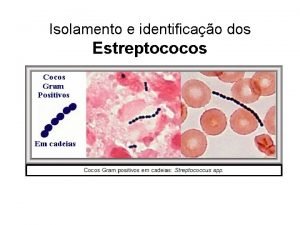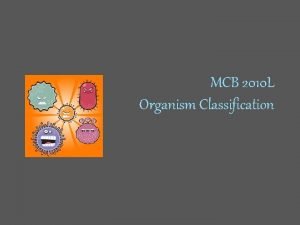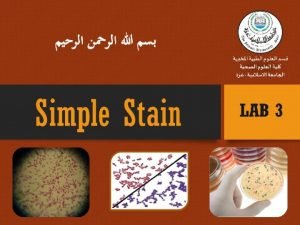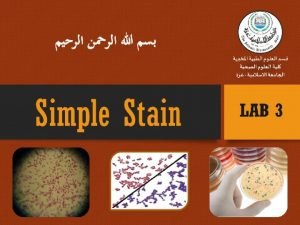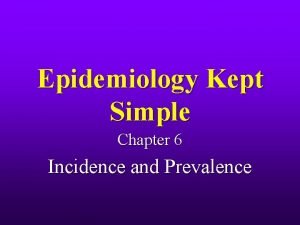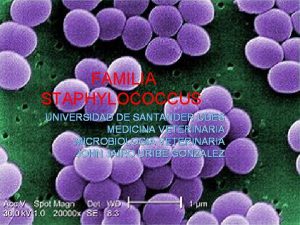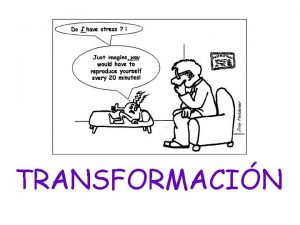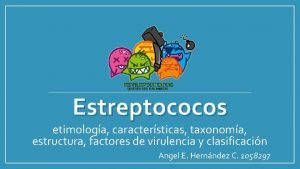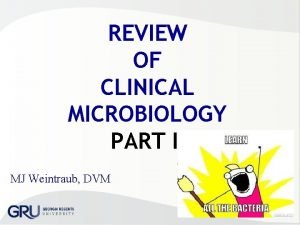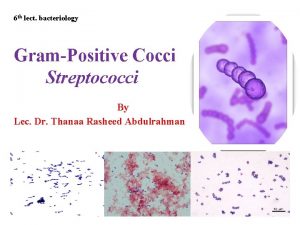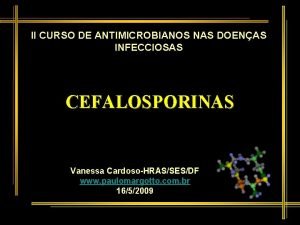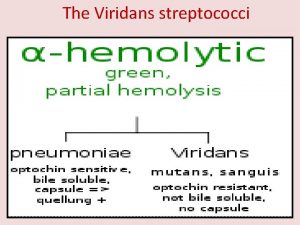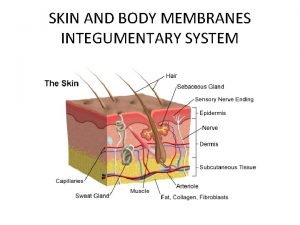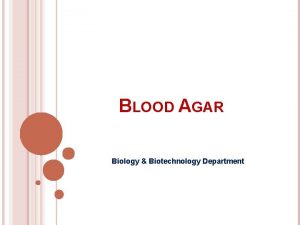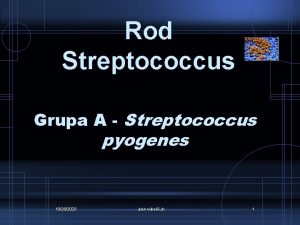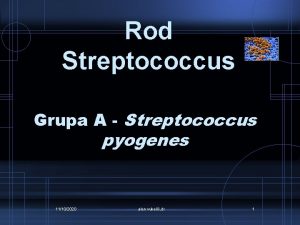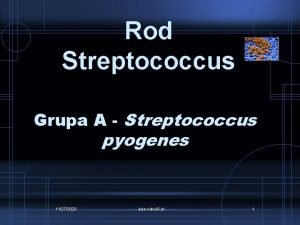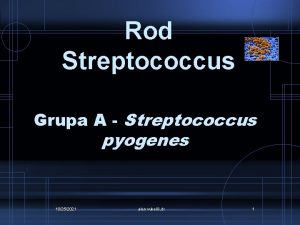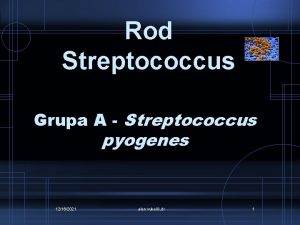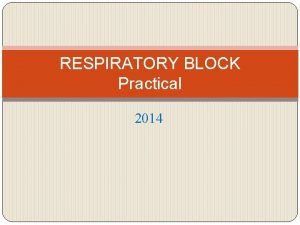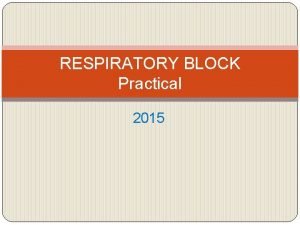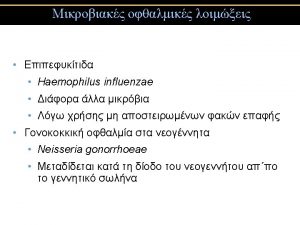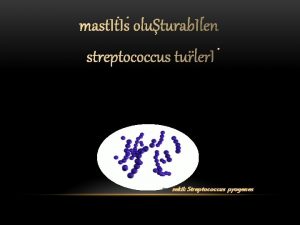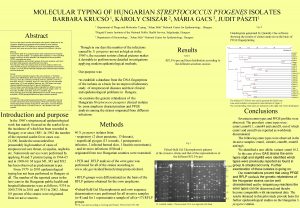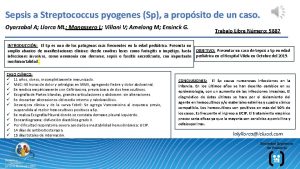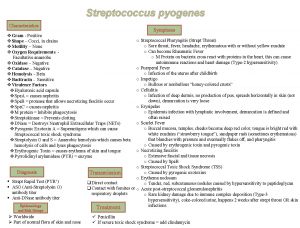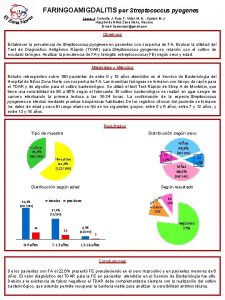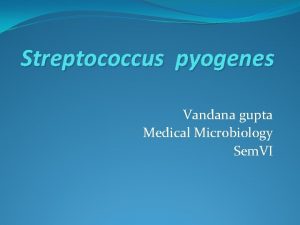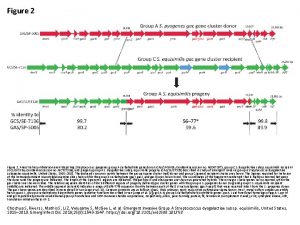Group A Streptococcus pyogenes Rising incidence of severe



















- Slides: 19

Group A Streptococcus pyogenes

Rising incidence of severe Invasive GAS disease JAMA, 1993; 269: 384 • Streptococcal toxic shock syndrome defined: – GAS infection – Hypotension – Multi-organ failure (2 or more of the following): • • • Hepatic involvement Renal involvement Gastrointestinal involvement ARDS Hematologic involvement – Generalized skin involvement




IGAS in Ontario, Canada NEJM, 1996; 335: 547 • Population-based surveillance, 1992 -3 in Ontario, Canada, N=323 patients: – 1. 5 per 100, 000 – Highest risk: • Very young, very old • 56% had underlying disease: – – – HIV Cancer Diabetes Alcohol abuse Chickenpox

IGAS in Ontario, Canada NEJM, 1996; 335: 547 • Clinical presentations: – – – Soft tissue infection Bacteremia without focus Pneumonia Necrotizing fasciitis STSS • Mortality – Over 64 years – STSS 15% 29% 81% 48% 14% 11% 6% 13%

IGAS Case Definition • Clinical description – Invasive group A streptococcal infections may manifest as any of several clinical syndromes, including pneumonia, bacteremia in association with cutaneous infection (e. g. , cellulitis, erysipelas, or infection of a surgical or nonsurgical wound), deep soft-tissue infection (e. g. , myositis or necrotizing fasciitis), meningitis, peritonitis, osteomyelitis, septic arthritis, postpartum sepsis (i. e. , puerperal fever), neonatal sepsis, and nonfocal bacteremia.

IGAS Case Definition (2) • Laboratory criteria for diagnosis – Isolation of group A Streptococcus (Streptococcus pyogenes) by culture from a normally sterile site (e. g. , blood or cerebrospinal fluid, or, less commonly, joint, pleural, or pericardial fluid) • Case classification – Confirmed: a case that is laboratory confirmed • Comment – See also Streptococcal toxic shock syndrome

STSS Case Definition • Streptococcal toxic-shock syndrome (STSS) is a severe illness associated with invasive or noninvasive group A streptococcal (Streptococcus pyogenes) infection. STSS may occur with infection at any site but most often occurs in association with infection of a cutaneous lesion. Signs of toxicity and a rapidly progressive clinical course are characteristic, and the case-fatality rate may exceed 50%.

STSS Case Definition (2) • Clinical case definition – An illness with the following clinical manifestations occurring within the first 48 hours of hospitalization or, for a nosocomial case, within the first 48 hours of illness: • Hypotension defined by a systolic blood pressure less than or equal to 90 mm Hg for adults or less than the fifth percentile by age for children aged less than 16 years. • Multi-organ involvement characterized by two or more of the following (next slide):

STSS Case Definition (3) Multi-organ involvement characterized by two or more of the following: 1. Renal impairment: 2. Coagulopathy: 3. Liver involvement: 4. Acute respiratory distress syndrome: 5. A generalized erythematous macular rash that may desquamate. 6. Soft-tissue necrosis, including necrotizing fasciitis or myositis, or gangrene. • Laboratory criteria for diagnosis • Isolation of group A Streptococcus.

STSS Case Definition (4) • Case classification – Probable: a case that meets the clinical case definition in the absence of another identified etiology for the illness and with isolation of group A Streptococcus from a nonsterile site. – Confirmed: a case that meets the clinical case definition and with isolation of group A Streptococcus from a normally sterile site (e. g. , blood or cerebrospinal fluid or, less commonly, joint, pleural, or pericardial fluid). • Comment – See also Streptococcal Disease, Invasive, Group A and Toxic Shock Syndrome

Public Health Action • Case ascertainment • Use the supplemental form to: – Document underlying disease – Document type of infection – If the case was hypotensive: • Determine if the case of invasive Group A Streptococcus meets the case definition for streptococcal toxic shock syndrome

Prophylaxis CID, 2002; 35: 950 • 2 studies identified 5 cases of household transmission in 2874 cases of IGAS, all adults. – Do not routinely screen or prophylax. – Health officials ‘may choose to’ offer prophylaxis to household contacts most at risk for sporadic disease or death • Health-case associated case: – Investigate one case (enhanced surveillance, typing) – Screening epi-linked health care workers is strongly recommended if > 2 cases occur in a 6 month period

IGAS - Outbreak Example JAMA, 1997; 277: 38 • February, 1995: 4 patients with IGAS; 2 deaths from STSS in a 10 -day period. • Action: – PFGE – Case definition: IGAS matching the outbreak strain with onset Jan 1 to Mar 31, 1995 in a 17 county area (subsequently revised to a 3 -county area) – Active surveillance – Survey of school children and patients with pharyngitis

IGAS - Outbreak Example (2) JAMA, 1997; 277: 38 • Results: – Case-finding: • 7 cases that matched by PFGE; ‘outbreak clone’ – 4 adults lived in community A served by school A – 4 deaths – Pharyngitis due to the outbreak clone • Community A: 7 (58%) of 12 persons with GAS • Community B: 69 (26%) of 260 persons with GAS

IGAS - Outbreak Example (3) School Survey JAMA, 1997; 277: 38 School Total students screened No (%) GAS isolates = outbreak clone A 187 No (%) with GAS 59 (32) X 337 53 (16) 0 (0) Y 260 30 (12) 3 (10) Z 299 68 (23) 1 (1) 46 (78)

IGAS/STSS Summary • STSS is more severe form of Streptococcus pyogenes infection – Highest risk in elderly and individuals with chronic underlying disease • Investigation: – Case ascertainment for IGAS and STSS – Document • Diagnosis • Underlying disease
 Micrococcaceae family
Micrococcaceae family Streptococcus pyogenes meio de cultura
Streptococcus pyogenes meio de cultura Saccharomyces domain
Saccharomyces domain Streptococcus pyogenes
Streptococcus pyogenes Streptococcus pyogenes morphology
Streptococcus pyogenes morphology Streptococcus pyogenes
Streptococcus pyogenes Prevalence calculation example
Prevalence calculation example Prevalence vs incidence
Prevalence vs incidence Hemolisis beta
Hemolisis beta Plasmidos
Plasmidos Estreptolisina o y s
Estreptolisina o y s Selective media for streptococcus pneumoniae
Selective media for streptococcus pneumoniae Streptococcus pneumoniae microscope
Streptococcus pneumoniae microscope Lancefield classification of streptococci
Lancefield classification of streptococci Streptococcus
Streptococcus Example of gram negative cocci
Example of gram negative cocci Draughtsman colony is a characteristic feature of
Draughtsman colony is a characteristic feature of Streptococcus aureus
Streptococcus aureus Streptococcus pneumoniae alpha or beta hemolysis
Streptococcus pneumoniae alpha or beta hemolysis Enterococcus faecalis
Enterococcus faecalis

